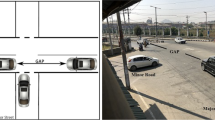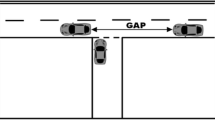Abstract
The paper presents results of research on the influence of the waiting time of drivers of subordinate movement on the time duration of the accepted gap and the number of vehicles using it to continue their journey at selected median, uncontrolled T-intersections with two two-lane main roadways, located in the Upper Silesian agglomeration. Facilities located within and outside built-up areas were selected for analysis. A two-stage waiting model was proposed for drivers of subordinate movements. With regard to the analysis of the number of vehicles merging or crossing the traffic and follow-up time, it was proposed to use a new indicator. A qualitative and quantitative study was conducted in the characteristics of traffic conditions and driver behaviour at selected intersections. The results of tests conducted in the afternoon rush hours confirmed the hypothesis about the lack of influence of drivers’ waiting time on the time duration of accepted gaps.
Access this chapter
Tax calculation will be finalised at checkout
Purchases are for personal use only
Similar content being viewed by others
References
Prasetijo, J., et al.: Capacity analysis of priority intersections with flare under mixed traffic conditions. Procedia Soc. Behav. Sci. 138, 660–670 (2014)
Kearney, J.K., Grechkin, T., Cremer, J., Plamert, J.: Traffic generation for studies of gap acceptance, pp. 177–186 (2006). https://citeseerx.ist.psu.edu/viewdoc/download?doi=10.1.1.122.6255&rep=rep1&type=pdf
Ashworth, R.: The capacity of priority-type intersections with a non-uniform distribution of critical acceptance gaps. Transp. Res. 3(2), 273–278 (1969)
Transportation Research Board: Highway Capacity Manual, National Research Council, Washington, DC (2000)
HBS. Handbuch fϋr die Bemessung von Strassenverkehrsanlagen. Forschungsgesellschaft für Straßen- und Verkehrswesen e. V., Köln (2001)
GDDKiA. MOP SBS. Metoda obliczania przepustowości skrzyżowań bez sygnalizacji świetlnej. GDDKiA, Warszawa (2004)
Beanland, V., Lenné, M.G., Candappa, N., Corben, B.: Gap acceptance at stop-controlled T-intersections in a simulated rural environment. Transp. Res. Part F. 20, 80–89 (2013)
Nabaee, S., Moore, D., Hurwitz, D.: Revisiting driver behavior at unsignalized intersections: time of day implications for two-way left turn lanes (TWLTL) In: Proceedings of the Sixth International Driving Symposium on Human Factors in Driver Assessment, Training and Vehicle Design, Olympic Valley - Lake Tahoe, California. Iowa City, IA, 27–30 June 2011. Public Policy Center, University of Iowa, pp. 440–446 (2011)
Hamed, M.M., Easa, S.M., Batayneh, R.R.: Disaggregate gap acceptance model for unsignalized T-intersections. J. Transp. Eng. 123(1), 36–42 (1997)
Rakha, H., Sadekb, S., Zohdyb, I.: Modeling differences in driver left-turn gap acceptance behavior using bayesian and bootstrap approaches. Procedia Soc. Behav. Sci. 16, 739–750 (2011)
Adebisi, O., Sama, G.N.: Influence of stopped delay on driver gap acceptance behavior. Transp. Eng. 115(3), 305–315 (1989)
Tian, Z.Z., et al.: Further investigation on critical gap and follow-up time. In: 4th International Symposium on Highway Capacity. Transportation Research Board, pp. 377–408 (2000). https://trid.trb.org/view/657360
Raff, M.S.: A volume warrant for urban stop signs. In: The Eno Foundation for Highway Traffic Control: Bureau of Highway Traffic Control, Yale University, Yale (1950)
Tanackov, I., Deretić, N., Bogdanović, V., Ruškić, N., Jović, S.: Safety time in critical gap of left turn manoeuvre from priority approach at TWSC unsignalized intersections. Physica A 505, 1196–1211 (2018)
Pawar, D.S., Patil, G.R.: Analyzing variations in spatial critical gaps at two-way stop controlled intersections using parametric and non-parametric techniques. J. Traffic Transp. Eng. (Engl. Ed.) 8(1), 129–138 (2021)
Witt, M., Kompaß, K., Wang, L., Kates, R., Mai, M., Prokop, G.: Driver profiling - data-based identification of driver behaviour dimensions and affecting driver characteristics for multi-agent traffic simulation. Transp. Res. Part F 64, 361–376 (2019)
Patil, G., Sangole, J.: Behavior of two-wheelers at limited priority uncontrolled T-intersections. Int. Assoc. Traffic Safety Sci. Res. 40, 7–18 (2016)
Barchański, A.: Analysis of critical gap times and follow-up times at selected, median, uncontrolled T-intersections differentiated by the nature of the surrounding. In: Macioszek, E., Sierpiński, G. (eds.) TSTP 2019. AISC, vol. 1083, pp. 242–256. Springer, Cham (2020). https://doi.org/10.1007/978-3-030-34069-8_19
Dissanayake, S., Lu, J.J., Yi, P.: Driver age differences in day and night gap acceptance capabilities. Int. Assoc. Traffic Safety Sci. Res. 26(1), 71–79 (2002)
DeJoy, D.M.: An examination of gender differences in traffic accident risk perception. Accid. Anal. Prev. 24(3), 237–246 (1992)
Yan, X., Radwan, E., Guo, D.: Effects of major-road vehicle speed and driver age and gender on left-turn gap acceptance. Accid. Anal. Prev. 39, 843–852 (2007)
Macioszek, E.: Empirical analysis of gap acceptance parameters at roundabouts located in Tokyo (Japan) and the Tokyo surroundings. In: Macioszek, E., Kang, N., Sierpiński, G. (eds.) TSTP 2019. LNITI. Springer, Cham (2020). https://doi.org/10.1007/978-3-030-39109-6_1
Macioszek, E.: Analysis of significance of differences between psychotechnical parameters for drivers at the entries to one-lane and turbo roundabouts in Poland. In: Sierpiński, G. (ed.) Intelligent Transport Systems and Travel Behaviour. AISC, vol. 505, pp. 149–161. Springer, Cham (2017). https://doi.org/10.1007/978-3-319-43991-4_13
Dutta, M., Ahmed, M.A.: Gap acceptance behavior of drivers at uncontrolled T-intersections under mixed traffic conditions. Mod. Transp. 26(2), 119–132 (2017). https://doi.org/10.1007/s40534-017-0151-9
Zohdy, I., Sadek, S., Rakha, H.: Empirical analysis of effects of wait time and rain intensity on driver left-turn gap acceptance behavior. Transp. Res. J. Transp. Res. Board 2173, 1–10 (2010)
Serag, M.S.: Gap-acceptance behaviour at uncontrolled intersections in developing countries. Malays. J. Civ. Eng. 27, 80–93 (2015)
Kaysi, I.A., Abbany, A.S.: Modeling aggressive driver behavior at unsignalized intersections. Accid. Anal. Prev. 39, 671–678 (2007)
Patil, G.R., Pawar, D.S.: Temporal and spatial gap acceptance for minor road at uncontrolled intersections in India. Transp. Res. 2461, 129–136 (2014)
Deo, P., Ruskin, H.J.: Urban signalised intersections: impact of vehicle heterogeneity and driver type on cross-traffic manoeuvres. Physica A 405, 140–150 (2014)
Aakre, E., Aakre, A.: Modeling cooperation in unsignalized intersections. Procedia Comput. Sci. 109C, 875–880 (2017)
Hobbs, F., Richardson, B.: Traffic Engineering, vol. 2. Pergamon Press, London (1967)
Gaca, S., Suchorzewski, W., Tracz, M.: Inżynieria ruchu drogowego. Teoria i praktyka. Wydawnictwo Komunikacji i Łączności, Warszawa (2011)
Bunden, W.: Introduction to Traffic Science. Printerhall Ltd., London (1967)
Tamhane, A.C.: Statistical Analysis of Designed Experiments. Theory and Applications. Wiley, New Jersey (2009)
Verbeek, M.: A Guide to Modern Econometrics, 2nd edn. Wiley, Chichester (2004)
Wikivoyage. https://pl.wikivoyage.org/
Mapa Targeo. https://mapa.targeo.pl/
Green, W.H.: Econometric Analysis. 7th edn. Prentice Hall, Hoboken (2012)
Aczel, A.D., Sounderpandian, J.: Statystyka w Zarządzaniu (In polish: Complete Business Statistics). PWN, Warszawa (2021)
Author information
Authors and Affiliations
Corresponding author
Editor information
Editors and Affiliations
Rights and permissions
Copyright information
© 2022 The Author(s), under exclusive license to Springer Nature Switzerland AG
About this paper
Cite this paper
Barchański, A. (2022). Impact of Drivers’ Waiting Time on the Gap Acceptance at Median, Uncontrolled T-Intersections. In: Macioszek, E., Sierpiński, G. (eds) Present Approach to Traffic Flow Theory and Research in Civil and Transportation Engineering. TSTP 2021. Lecture Notes in Intelligent Transportation and Infrastructure. Springer, Cham. https://doi.org/10.1007/978-3-030-93370-8_11
Download citation
DOI: https://doi.org/10.1007/978-3-030-93370-8_11
Published:
Publisher Name: Springer, Cham
Print ISBN: 978-3-030-93369-2
Online ISBN: 978-3-030-93370-8
eBook Packages: EngineeringEngineering (R0)




